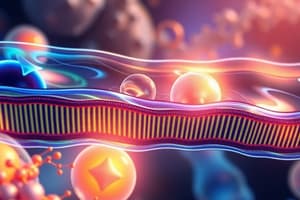Podcast
Questions and Answers
What components primarily make up the hydrophobic tails of phospholipids?
What components primarily make up the hydrophobic tails of phospholipids?
- Nucleic acids
- Amino acids
- Phospholipids
- Fatty acids (correct)
What is the primary role of cholesterol in the cell membrane?
What is the primary role of cholesterol in the cell membrane?
- Decreases membrane fluidity at all temperatures
- Increases membrane fluidity in response to temperature changes (correct)
- Acts as a barrier to all substances
- Prevents the formation of lipid tails
Which statement correctly describes integral membrane proteins?
Which statement correctly describes integral membrane proteins?
- They do not interact with the lipid bilayer.
- They help in cell-to-cell recognition.
- They are only found on the surface of the membrane.
- They completely span the lipid bilayer. (correct)
What is one of the functions of membrane proteins?
What is one of the functions of membrane proteins?
What describes the arrangement of phospholipids in the cell membrane?
What describes the arrangement of phospholipids in the cell membrane?
Which type of carbohydrate is commonly found in cell membranes and assists in signal recognition?
Which type of carbohydrate is commonly found in cell membranes and assists in signal recognition?
What happens to cholesterol when temperatures increase in the membrane?
What happens to cholesterol when temperatures increase in the membrane?
In the fluid mosaic model, what term describes the movement of molecules within the membrane?
In the fluid mosaic model, what term describes the movement of molecules within the membrane?
Flashcards are hidden until you start studying
Study Notes
The Fluid Mosaic Model
- Proposed by S. Jonathan Singer and Garth Nicolson in 1972.
- Describes the arrangement and movement of lipids and proteins in the cell membrane.
- Lipids are hydrophobic due to their hydrocarbon composition.
- Phospholipid molecules have a hydrophilic phosphate head and hydrophobic fatty acid tails.
- Phospholipid bilayer: heads face outward toward water, tails face inward away from water.
Fatty Acids
- Unsaturated fatty acids contain double bonds, creating kinks.
- Saturated fatty acids consist of single bonds and have a linear structure.
- Cholesterol helps maintain membrane fluidity by occupying kinks of unsaturated fatty acids, especially during temperature fluctuations.
Membrane Proteins
- Integral Membrane Proteins: Span the bilayer, interacting with both hydrophilic and hydrophobic regions.
- Peripheral Membrane Proteins: Positioned on the membrane surface and do not penetrate the bilayer.
Functions of Membrane Proteins
- Signal transmission between cells.
- Enzymatic activity to facilitate biochemical reactions.
- Cell-to-cell recognition for immune response and tissue formation.
- Attachment to cells and other molecules for structural support.
- Transport functions to move substances across the membrane.
Carbohydrates in Membranes
- Serve as sources of energy, including sugars, starch, and glycogen.
- Found in the cell membrane as components of glycoproteins, where carbohydrates are attached to proteins for cell recognition and signaling.
Studying That Suits You
Use AI to generate personalized quizzes and flashcards to suit your learning preferences.




